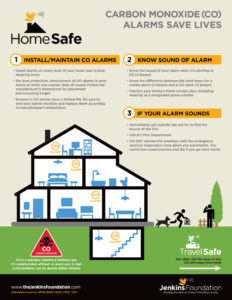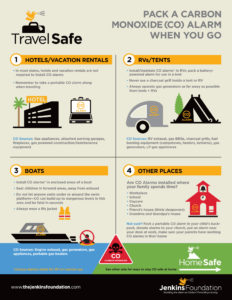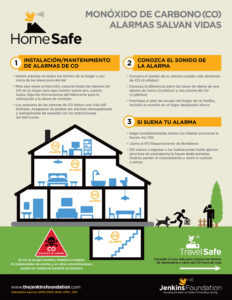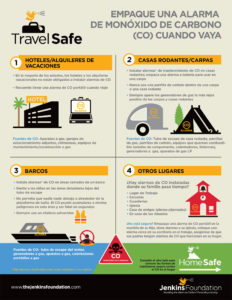Alarms
ALL homes should be equipped with carbon monoxide (CO) alarms: on all occupiable levels and near all sleeping areas. If you can only afford one alarm, place it near sleeping areas so it can awaken you if you are sleeping. Carbon monoxide is invisible and has no odor. High levels can incapacitate and kill within minutes. A CO alarm alerting in a 4-beep pattern means get outside to fresh air right away.
Did you know CO alarms sound different than smoke alarms?
- Smoke alarms alert in a 3-beep pattern, CO alarms alert in a 4-beep pattern. These are standardized alert tones (some are also “talking” alarms and speak voice alerts with instructions).
👂 Smoke alarm alert tones sound like this:
👂 CO alarm alert tones sound like this:
What do the alarms in your home sound like?
- Press the TEST button and find out. Press the Test button on your alarms at least once a month to make sure the both the alarm and the batteries are in good working order. Including your children in monthly testing of your alarms is a great way for them to become familiar with the alert tones and be reminded of what to do when the alarm sounds.
- Be aware that CO alarms have alternate beep patterns to signal a dead battery, an alarm malfunction, or an expired alarm (CO alarms have a sensor that expires after 7-10 years, at which time the entire alarm must be replaced). READ the instruction manual that comes with your alarm to become familiar with how it works and sounds.
Does everyone in your home know what to do when the alarm sounds?
If you hear your alarm alerting in a 4-beep pattern, it is warning of the presence of carbon monoxide (remember you can’t see it or smell it – you won’t know it’s there):
- Immediately get outside to fresh air and call 911
- DO NOT TRY TO FIND THE SOURCE OF THE CO
- Do not return inside until firefighters tell you it’s safe to do so
People are particularly at risk of dying if they are exposed to carbon monoxide while sleeping – it’s critical for everyone in your home to be able to recognize the 4-beep alert tone in order to take quick action to get to fresh air
Our CO Alarm HomeSafe flyer lists all of this information and can be printed. Post it where it’s visible to everyone in your home as a reminder of what to do in a carbon monoxide emergency. Keep an extra copy with your travel CO alarm – remember, carbon monoxide poisoning can happen anywhere.
English:
Print HomeSafe Print TravelSafe
Spanish:
Print HomeSafe Print TravelSafe
Carbon monoxide alarms can be purchased online and in most home improvement stores. Be sure to only purchase NRTL certified alarms. According to the National Fire Protection Association, “Interconnected CO alarms offer the best protection; when one sounds, they all do. A licensed electrician can install hard-wired interconnected CO alarms, or homeowners can install wireless alarms, plug-in alarms, or battery-operated alarms.”
👉 Consumer Reports: Best Smoke and CO Alarms of 2024
Having carbon monoxide alarms in your home is just the first step in staying safe from carbon monoxide poisoning. For additional ways to safeguard you and your family at home, click here to go to our CO page.
Need more encouragement to have working CO alarms? Check out these real-life stories:
https://thejenkinsfoundation.com/category/co-incidents/homes/
Sources for information referenced on this page: NFPA, CDC, CPSC







